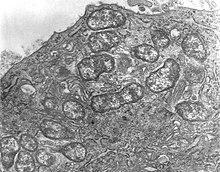Tsutsugamushi fever
The scrub typhus (also: Scrub Typhus fever, or Japanese flow) is one with the spotted fever comparable infectious disease.
The pathogen is the bacterium Orientia tsutsugamushi ( belonging to the Rickettsiaceae ). It is transmitted by mites , which are part of the trombidiformes . They prefer to sit on bushes, which is also what the name scrub refers to. The small bite wound becomes visible like a necrosis .
Symptoms of the disease include fever, muscle pain and rash, and other non-specific symptoms. Splenomegaly , lymphadenopathy, and leukopenia can be observed. A method developed by Edmund Weil and Arthur Felix , which is based on a cross-reaction between Rickettsial antibodies and Proteus antigens , can be used for a specific diagnosis . Immunofluorescence is better suited for laboratory confirmation, but is often not available in the area of distribution.
A vaccine is not available because different strains of the pathogen are known that differ in their antigenic pattern. Insect repellants are therefore suitable for prophylaxis . Since the disease can be fatal if left untreated, antibiotics are used. Doxycycline is the standard drug, but because of the development of resistance, other antibiotics must be used in some cases.
The area of distribution is Asia , this infection can also occur in the bordering regions of Australia and Oceania and as far as India . It is often not recognized in rural areas due to the lack of diagnostic options. After the Tōhoku earthquake in 2011 , the disease broke out in Japan . During World War II , the Merrill's Marauders were affected.
In September 2016, three autochthonous cases were described for the first time on the Chilean island of Chiloé .
literature
- Burkhard Enders: Zoonoses: infectious diseases that can be transmitted from animal to human . P. 302.
- Dieter Adam: Infectiology . P. 908.
- Rüdiger Braun (Hrsg.): Travel and Tropical Medicine: Course book for further training, practice and advice . P. 89.
- Rickettsial Infections and Fever, Vientiane, Laos . In: Emerging Infectious Diseases journal. CDC
- JS Kang, WH Chang: Antigenic relationship among the eight prototype and new serotype strains of Orientia tsutsugamushi revealed by monoclonal antibodies . In: Microbiology and Immunology . tape 43 , no. 3 , 1999, ISSN 0385-5600 , p. 229-234 , PMID 10338191 .
- After the tsunami, mites threaten Japan .
Individual evidence
- ^ T. Weitzel, S. Dittrich, among others: Brief Report: Endemic Scrub Typhus in South America. In: N Engl J Med. 375, 2016, pp. 954-961. doi: 10.1056 / NEJMoa1603657
